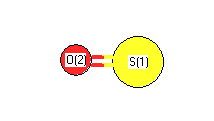Jump to
S2C1
Energy calculated at BLYP/cc-pV(T+d)Z
| | hartrees |
|---|
| Energy at 0K | -473.416574 |
| Energy at 298.15K | |
| HF Energy | -473.416574 |
| Nuclear repulsion energy | 44.734879 |
The energy at 298.15K was derived from the energy at 0K
and an integrated heat capacity that used the calculated vibrational frequencies.
Geometric Data calculated at BLYP/cc-pV(T+d)Z
Point Group is C∞v
Cartesians (Å)
| Atom |
x (Å) |
y (Å) |
z (Å) |
|---|
| S1 |
0.000 |
0.000 |
0.505 |
| O2 |
0.000 |
0.000 |
-1.009 |
Atom - Atom Distances (Å)
 More geometry information
More geometry information
Electronic energy levels
Charges, Dipole, Quadrupole and Polarizability
Charges from optimized geometry at BLYP/cc-pV(T+d)Z
Charges (e)
| Number |
Element |
Mulliken |
CHELPG |
AIM |
ESP |
| 1 |
S |
0.288 |
|
|
|
| 2 |
O |
-0.288 |
|
|
|
Electric dipole moments
Electric dipole components in Debye
(What's a Debye? See section
VII.A.3)
| |
x |
y |
z |
Total |
| |
0.000 |
0.000 |
1.488 |
1.488 |
| CHELPG |
|
|
|
|
| AIM |
|
|
|
|
| ESP |
|
|
|
|
Electric Quadrupole moment
Quadrupole components in D Å
| Primitive |
|---|
| | x | y | z |
|---|
| x |
-17.590 |
0.000 |
0.000 |
| y |
0.000 |
-17.590 |
0.000 |
| z |
0.000 |
0.000 |
-18.110 |
|
| Traceless |
|---|
| | x | y | z |
|---|
| x |
0.260 |
0.000 |
0.000 |
| y |
0.000 |
0.260 |
0.000 |
| z |
0.000 |
0.000 |
-0.521 |
|
| Polar |
|---|
| 3z2-r2 | -1.041 |
|---|
| x2-y2 | 0.000 |
|---|
| xy | 0.000 |
|---|
| xz | 0.000 |
|---|
| yz | 0.000 |
|---|
|
Polarizabilities
Components of the polarizability tensor.
Units are
Å
3 (Angstrom cubed)
Change units.
| |
x |
y |
z |
| x |
2.079 |
0.000 |
0.000 |
| y |
0.000 |
2.079 |
0.000 |
| z |
0.000 |
0.000 |
3.851 |
<r2> (average value of r
2) Å
2
| <r2> |
23.322 |
| (<r2>)1/2 |
4.829 |
Jump to
S1C1
Energy calculated at BLYP/cc-pV(T+d)Z
| | hartrees |
|---|
| Energy at 0K | -473.370098 |
| Energy at 298.15K | |
| HF Energy | -473.370098 |
| Nuclear repulsion energy | 45.156455 |
The energy at 298.15K was derived from the energy at 0K
and an integrated heat capacity that used the calculated vibrational frequencies.
Vibrational Frequencies calculated at BLYP/cc-pV(T+d)Z
Geometric Data calculated at BLYP/cc-pV(T+d)Z
Point Group is C∞v
Electronic energy levels
Charges, Dipole, Quadrupole and Polarizability
